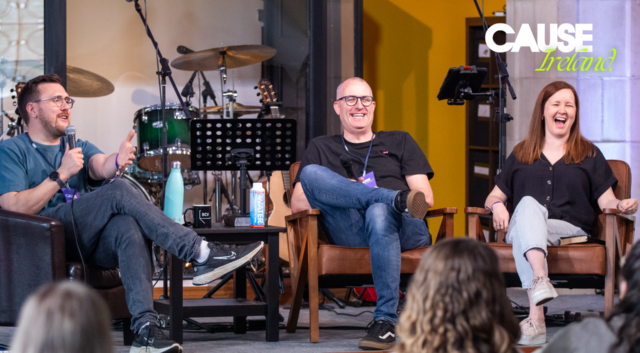As we come to terms with a new reality, one of the most important connection points for churches is our Small Groups. So how can we continue to meet digitally and what tools are available to us?
In this resource we’ll look specifically at Zoom, Google Hangouts, Skype and Facebook Groups, which are all available on Windows, Mac, Tablets and Mobile devices and how they could be really helpful to you and your small groups.
Community is so important at these times, especially where gatherings are not possible, so do encourage your Small Groups to make use of technology to continue connecting with their Small Group community, friendship circles, and families.
To help you choose the online tool right for you, further down on this page we have listed is a run-down of some of the more popular choices, with some helpful links. Any tool is only as good as the internet connections for all users, so do bear that in mind when using them.
How could Small Groups work digitally?
The Small Group leader will set up a meeting using a digital platform and circulate a link to the small group. Each member can then use this link on their phone, tablet or computer to join in, regardless of their location, allowing everyone to join together to see faces and hear familiar voices from their Small Group.
Discussions, prayer, encouragement, worship and fun can all happen online, albeit slightly differently.
If you’re not used to using video conferencing tools, it can be a little intimidating. Fortunately, all the options we have listed are much simpler than they can sound.
Most Small Groups have a technical person in them, if you’re unsure what you are doing after reading this guide, it may be a good idea to ask for some help in getting yourself set up.
It’s important to have a dry run through with a couple of people before you get to your Small Group start time, this way you can iron out any problems you have.
Some Small groups around the country are already finding that people who wouldn’t normally be at Small Group are loving this option and are getting involved.
It may take a little getting used to. If you feel a little intimidated, enter this with a thought process of, this is going to be fun. It’s new to lot’s of people and over time you will get used to how this works and your group dynamic will also develop over the weeks.
Familiarise yourself by having one to one chats over the platform to help you get used to the technology and allow members of your group to get used to it as well. It’s easy to spend time looking at yourself at the bottom of the screen, don’t worry about what you look like and, if you would like, on some platforms you can hide your own picture.
Many of the conferencing platforms have chat functions as well, this is great if you want to send links to Bible verses or other media you are using during your group.
Close your time together in prayer. Ask everybody if they have prayer requests. You can also use the chat functions to write these down as people are sharing if you would find that helpful. As the leader, pray and ask God to meet each person’s needs.
YouVersion (the Bible app) has a new prayer function, have an explore of this and ways you can keep in touch with people and their prayer requests during the week. You could also make use of WhatsApp or Facebook by setting up a group for your small group to keep in touch and to share prayer requests.
Don’t be disappointed if your group is smaller than it would be face to face, these platforms take time for everyone to get used to. Make sure you connect with those unable to be present so that no one feels disconnected in this time, especially those vulnerable, at-risk, unwell or self-isolating.
Above all, keep the sense of fun and community you have in your homes, make sure people still have their tea and coffee and that we can glorify God through many different means even when we’re not together in person.
Tools
Here are some of the tools that are simple to use and could work for you. Have a read and work out which ones you would like to try.
Zoom
Zoom focuses on delivering high-quality video, so you can invite a Small Group onto a ‘call’ and see and hear each other. Everyone can speak, hear and contribute.
Zoom is an industry-standard tool and comes with more features than a Small Group will need, but the quality of video and audio is higher, which is one of its key benefits.
To use it, all users will need to download Zoom onto their computer or device, but once it’s been downloaded once this is a very simple option.
Zoom offers a free account, which limits your calls to 40-minutes. To remove that limit it costs $14.99/month. This amount is only payable by the ‘host’, your Small Group participants don’t need to pay anything, but may need a user guide to help get them set up for the first time.
If you decide to use the free version, you could plan for two 40-minute calls, with a comfort break and tea break in the middle, to make it feel more natural.
Pros
- You can host large numbers on Zoom.
- There are no limits to the number of meetings you can have.
Cons
- Small Groups would be limited to 40 minutes on the free version.
- Participants need to download Zoom and become accustomed to how it works.
Start with Zoom | Help with Zoom
Verdict
If you can pay $14.99 a month, this is a great option, which allows Small Groups to meet. The free version is limited in time length but does allow for high-quality connection.
Google Hangouts
Google’s option requires you to have a google account, which is free to create. It works in the browser, but also has mobile and tablet apps you can download.
The Small Group leader starts a call and can either invite people in or can circulate a link to Small Group members that they can click on and join the video call.
Pros
- Hangouts is free, and if you’re used to using Google and Android products, it can be a very natural fit.
- Simple and high quality
- Free
Cons
- Google Hangouts works with your existing contacts, but you can share a link to your Small Group if you don’t have everyone’s google email address.
- Video quality is not as high as Zoom.
Start with Google Hangouts | Help with Google Hangouts
Skype
Skype has been around for a while and the majority of people are familiar with the name, even if they don’t use it. Skype has continued to improve it’s call quality since it first launched and is a stable and useful tool.
You don’t need a skype account to use it. It’s now possible to send a link to anyone, which they can use to access a group call. As with Zoom and Hangouts, you can use this on a mobile device.
Pros
- People are familiar with the name.
- Free for up to 50 people.
- Participants don’t need a skype account.
Cons
- Quality is not as high as other free options.
- Layout and registration can be confusing.
Start with Skype | Help with Skype
Facebook Messenger
Facebook Messenger is more than just a chat feature. It also has the ability to allow groups and individuals to create a video call, without charge.
Pros
- Uses a platform that many are already used to.
- Can work easily if your Small Group already has a private Facebook Group.
- Free
- Works with up to 50 people
Cons
- You can only see 6 people at a time on the screen.
- You need a Facebook account to use this and not everyone uses Facebook, so this may make this option inaccessible to some.
Start with Facebook Messenger | Help with Facebook Messenger
Practically, what do you need to think through?
Before Small Groups
- Make sure you are familiar with the tool you are going to use.
- Do a trial run with a few people before the group, so you can make this tool easy to use for everyone.
- Send instructions and any user guides (links above) to your group.
- If you have any people in your Small Group who are not comfortable with technology. see if you can help them get setup before hand, by phoning them and talking them through the steps. In this way, you can make sure no one is excluded.
During Small Group
- Welcome your group as people log in. It may take a little while for everybody to get on to the call, so don’t start until you think everyone is on.
- Remember to pause, give people time to speak, people are a little slower to respond online than they are face to face. It may be helpful to ask individuals their thoughts on a question so other people know somebody is going to speak.
- As you end, make sure everyone knows that you are ending your time together, let them know to leave the video chat and then stop the meeting.
After Small Group
- Thank everyone for joining with you.
- Encourage everyone to stay in touch using whichever tools you use as a Small Group – Facebook Group, WhatsApp group, or Email.
- Make sure everyone knows how you will be meeting as a Small Group and where to find instructions for the next Small Group.









